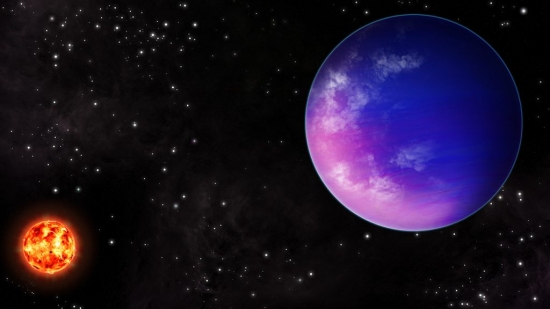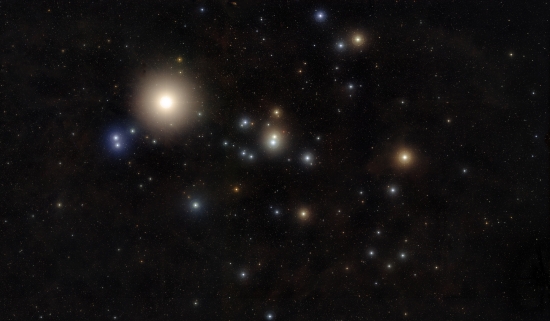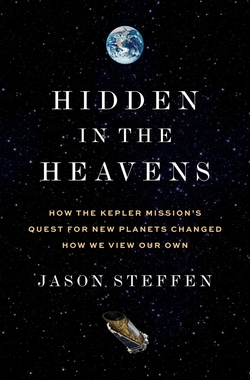The exoplanet K2-25b, a young world in the Hyades cluster orbiting an M-dwarf star, raises intriguing questions. We’d like to know how it formed, for K2-25b is much more dense than we would expect for a world slightly smaller than Neptune. Planets in a range between Earth and Neptune seem to be common around other stars, although we have none in our Solar System unless we make an interesting discovery about putative Planet 9.
But let lead author Gudmundur Stefánsson (Princeton University) point out the unusual nature of K2-25b::
“The planet is dense for its size and age, in contrast to other young, sub-Neptune-sized planets that orbit close to their host star. Usually these worlds are observed to have low densities — and some even have extended evaporating atmospheres. K2-25b, with the measurements in hand, seems to have a dense core, either rocky or water-rich, with a thin envelope.”

Image: New detailed observations with NSF’s NOIRLab facilities reveal a young exoplanet, orbiting a young star in the Hyades cluster, that is unusually dense for its size and age. Slightly smaller than Neptune, K2-25b orbits an M-dwarf star — the most common type of star in the galaxy — in 3.5 days. Credit: NOIRLab/NSF/AURA/J. Pollard.
Let’s put this world into the context of giant planet formation because of its unusual density. A widely studied scenario would have gas giants forming through the accretion of disk materials into a core of ice and rock some 5 to 10 times the mass of Earth. A massive gas envelope hundreds of times the mass of Earth is then drawn in through gravitational interaction with the still young disk. K2-25b’s mass — some 25 times that of Earth, and thus possessed of robust gravitational pull — has emerged without accumulating more than a tenuous gas envelope.
This planet is a Kepler discovery and a world producing a large transit depth, one mentioned in the literature as a candidate for atmospheric characterization by the James Webb Space Telescope. Particularly useful is the fact that its mass, radius and even the tilt of its orbit have been determined with the help of the Habitable-zone Planet Finder (HPF), a spectrograph out of Penn State installed on the 10-meter Hobby-Eberly Telescope at McDonald Observatory in Texas.
The size measurement was tightened with observations at Kitt Peak’s WIYN 0.9-meter telescope and the 3.5-meter telescope at Apache Point Observatory in New Mexico. I mention both because Stefánsson subjected their data to an engineered diffuser, a beam shaper that effectively spreads the light from the star to allow more accurate measurements of the planetary transit. This in turn allows transit prediction for K2-25b to be reduced from a window of 30-40 minutes to 20 seconds in a technique Stefánsson developed in his doctoral thesis.
Here you may remember Stefánsson’s name in connection with the exoplanet G 9-40b, where he used diffuser-assisted photometry at Apache Point to tighten transit timing (see G 9-40b: Confirming a Planet Candidate). Tightening the shape of the transit can be invaluable, says Jayadev Rajagopal (National Optical-Infrared Astronomy Research Laboratory), a co-author of the paper:
“The innovative diffuser allowed us to better define the shape of the transit and thereby further constrain the size, density and composition of the planet. Smaller aperture telescopes, when equipped with state-of-the-art, but inexpensive, equipment can be platforms for high impact science programs. Very accurate photometry will be in demand for exploring host stars and planets in tandem with space missions and larger apertures from the ground, and this is an illustration of the role that a modest-sized 0.9-meter telescope can play in that effort.”
The authors of the paper on this work consider K2-25b to be a ‘useful laboratory’ for examining planet formation. If so, it’s a laboratory with unexplained secrets. Why didn’t K2-25b experience runaway gas accretion to produce a gas giant? The paper offers one possible solution:
…we surmise that K2-25b could be the product of planet merging events of smaller planetary cores to produce a more massive planet. Such a dynamical environment could have excited K2-25b into an eccentric orbit, and K2-25b could be in the process of migrating to a shorter period orbit through tidal interactions with the host star. To explain K2-25b’s current moderate eccentricity from tidal circularization theory, we place a lower limit on the tidal quality factor of Qtp ? 105, corresponding to a circularization timescale consistent with the age of the system. This tidal quality factor is higher than the tidal quality factor for Neptune, which suggest that K2-25b’s internal structure could be different than that of the small gas-giants (Uranus, Neptune) in the Solar System.

Image: Wide-field view of the Hyades star cluster created from images forming part of the Digitized Sky Survey 2. Credit: NOIRLab/NSF/AURA/Digitized Sky Survey 2.
Follow-up observations will include transit spectroscopy on data from the Transiting Exoplanet Survey Satellite (TESS) mission, whose target list includes K2-25b. Also useful will be NEID, an extreme precision radial velocity spectrometer installed at Kitt Peak’s WIYN telescope. A pertinent astronomical reference is TOI 849b, a possible exposed planetary core — see An Exposed Planetary Core at TOI-849 for more on this one and its similar issues re planet formation.
The paper is Stefánsson et al., “The Habitable-zone Planet Finder Reveals A High Mass and a Low Obliquity for the Young Neptune K2-25b,” accepted at the Astronomical Journal (preprint).



Have the authors ruled out that it could be a normal Neptune, but with its atmosphere stripped by its star, perhaps by particularly large and/or frequent flaring?
Thousands of Earthlike ‘blanets’ might circle the Milky Way’s central black hole
By Rafi Letzter a day ago
A new, strange sort of world might orbit the giant black hole at the center of the Milky Way.
https://www.space.com/black-hole-planets-blanets.html
Fascinating. I never realized the dust at such tremendous distances (2-3 pc!) from a supermassive black hole could be dense enough to create a planet. The authors demonstrate these planets can’t accumulate much of a gaseous envelope during formation, but nothing is said of secondary atmosphere. This certainly seems to undercut some gloomy prognostications of the late universe when “nothing remains but black holes”. The calculation for how many can orbit in the habitable zone should be more than amusing.
But I do abhor the term “blanet”. It reminds me of cosmonauts and taikonauts and spationauts and angkasawans. Will we call pulsar planets pulanets, or when the neutron star doesn’t point its beam at Earth maybe [i]nsanets?
While an advanced ETI may not need a planet or blanet to survive around a black hole, it is nice to know they could exist.
Also see these two items:
https://phys.org/news/2020-06-year-old-theory-alien-civilization-exploit.html
https://arxiv.org/ftp/arxiv/papers/1104/1104.4362.pdf
K2-25b is too far from the star and too massive to have been a larger gas giant that lost it’s atmosphere from atmospheric stripping because it has 11 times the mass of Earth with a strong gravity. One idea might be there is less gas in a smaller M dwarf accretion disk so K2-25b started out with a large, dense body, like a rocky planet, but could not grab enough gas due to its lose proximity to the star which grabbed up most of the gas, i.e., the most practicable answer is sometimes correct.
The gas cloud in the accretion disk was less massive otherwise it would be large gas giant like Jupiter or Neptune.
I wondered why you didn’t say anything about its distance from its star, went to look it up and it appears to be unknown. I was under the mistaken impression that if a planet’s mass and its sun’s mass were known, and if its orbital period were known, then we could determine its orbital radius. What is the missing information that we know for other exoplanets that allows us to routinely determine the distance from their star?
The paper (linked at the end of the blog post) gives the semi-major axis in table 5. Value is 0.0287 AU (21.09 stellar radii).
Present period astronomy significantly advances in observations, but mostly fails to explain achieved data. Most “explanation” seams to be mostly speculations, probably to build trustful theory we need to collect significantly more exoplanets observations big database will allow to build some type of classification that close to reality.
Meanwhile almost every new found planet advertised in media as “unusual”, non explained etc…
Despite , I suppose thar everything “unusual” , that we are finding this period in very limited (by numbers and instrument’s resolution) dataset, most probable – it is widespread, normal and nothing unusual…
Hi Paul
I wounder if there is a diagram showing the interior structure of this planet?
Cheers
Not to my knowledge, I’m afraid.
One Key info regarding the formation solar systems is missing.
The content and position of the collapsing nebula before stellar ignition
We need to look at hundreds of Stellar nurseries and stellar beehive(like the Pleiades) and parse out their contents with spectrographs. Hopefully the new WEBB telescope can enhance that data set.
A couple of comments above were to the effect of what was the
effective separation between the planet and the star described.
Here are some estimates. By chance the period (~3.5 days) is about .01 of the Earth’s orbital period ( using 3.65) and a faint red dwarf might have a mass of 0.08 to 0.1 that of the sun. By that reckoning the semi major axis AU distance is from 0.02 to 0.0215 AU or on order of 3 million kilometers.
This looks to me akin to a system like that of Trappist 1 – save for all the billiard balls seeming to have gone down the same hole. When you look at Trappist 1, you have to wonder what holds it together for – billions of years? This might be what happens if something goes awry.
In theory K2-25b could have been like Neptune and lost its atmosphere due to x ray radiation and solar wind stripping as Alex Tolley has written, but that would be a lot of lost atmosphere and using the model of the Trappist-1 system which has some planets at that distance or orbits of only 3 days and all of them short revolution times, so it’s inner planets would little or no atmosphere. I think this is lees probable because the atmospheres like on Venus are pretty robust and hard to loose and gas giants with a larger gravity are even more robust. I expect to see atmospheres on most of the Trappist system planets since they are all close to the size the Earth. We shall see later. The JWST launch has been delayed until October 31, 2021 due to covid 19 and reduced work time, but that is not that much more of a wait.
About JWST: Just keep in mind it is going to take time to deploy the instruments and shields on the satellite, then we have about 6 months of calibrations, etc. This does not include any issues that might occur along the way.
See this animated launch and deployment sequence here, which includes the time factors:
https://www.youtube.com/watch?v=v6ihVeEoUdo
It is also very concerning that in-orbit repair for JWST was not included in the flight and mission plan, so far as I know. Just imagine if the Hubble Space Telescope could not have been repaired.
A lesser known example is the Compton Gamma Ray Telescope launched in 1991 during the STS-37 mission. The high-gain antenna (HGA) would not deploy, even when they tried to use the Remote Manipulator Arm on the Space Shuttle. It took a spacewalk to solve the problem, which the astronaut did in just 17 minutes.
https://en.wikipedia.org/wiki/STS-37
JWST is far more complex in both design and deployment. I hope this means it will therefore work as planned, but Murphy’s Law seems to just love these kinds of situations. Perhaps SpaceX or even Orion can come to the rescue if a problem arises.
This comment speaks to the debate between manned and robotic missions very well, showing that in reality, both are needed.